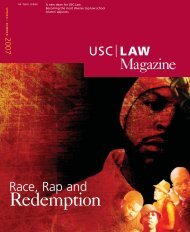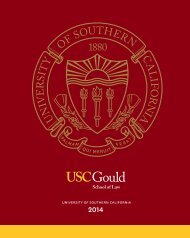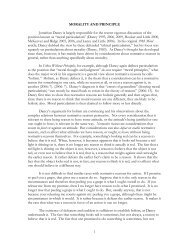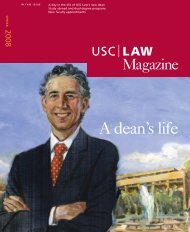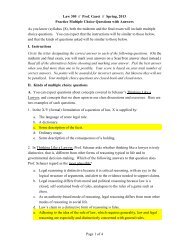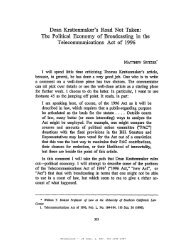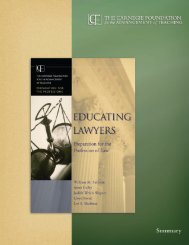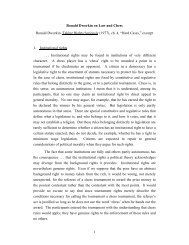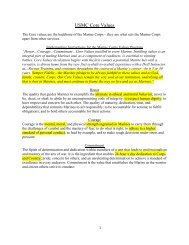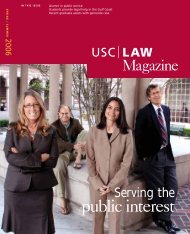EIN NLINE
EIN NLINE
EIN NLINE
Create successful ePaper yourself
Turn your PDF publications into a flip-book with our unique Google optimized e-Paper software.
Citation: 107 Harv. L. Rev. 1993-1994<br />
Content downloaded/printed from<br />
HeinOnline (http://heinonline.org)<br />
Fri Sep 25 12:54:10 2009<br />
-- Your use of this HeinOnline PDF indicates your acceptance<br />
of HeinOnline's Terms and Conditions of the license<br />
agreement available at http://heinonline.org/HOL/License<br />
-- The search text of this PDF is generated from<br />
uncorrected OCR text.<br />
-- To obtain permission to use this article beyond the scope<br />
of your HeinOnline license, please use:<br />
https://www.copyright.com/ccc/basicSearch.do<br />
&operation=go&searchType=0<br />
&lastSearch=simple&all=on&titleOrStdNo=0017-811X
VISUAL ARTISTS' RIGHTS IN A DIGITAL AGE*<br />
"[I]t is almost obligatory... to begin by invoking the 'communications<br />
revolution' of our time, then to pronounce upon the inadequacies of<br />
the present copyright act ... "<br />
BENJAMIN KAPLAN, AN UNHURRIED VIEW OF COPYRIGHT'<br />
Over twenty-five years ago, Professor Benjamin Kaplan alluded<br />
to the steady stream of commentary critical of the copyright system's<br />
ability to respond to a constant progression of technological advances. 2<br />
That stream of criticism continues today. 3 Modern commentators,<br />
however, whether critical or laudatory of American copyright law,<br />
often do not explicitly acknowledge the recent changes in American<br />
copyright that attempt to harmonize the American system with that<br />
of other countries. The globalization of the entertainment industry<br />
has brought an increased interest in the various legal systems used to<br />
protect intellectual property around the world, 4 and the changing<br />
contours of entertainment-product marketing have placed a premium<br />
on attempts to harmonize intellectual property protection internationally.<br />
As one commentator notes:<br />
Suddenly, or so it appears, copyrights have been promoted from<br />
pawns to queens on the global chessboard. Originally the province of<br />
artists and their patrons, then growing into major industries, copyright<br />
and [like doctrines] now preoccupy those conducting affairs of<br />
state. . . . In short, transmedia communications are a new empire,<br />
and all of us are its subjects. 5<br />
* A revised version of this Note is currently under consideration in the 1994 Nathan Burkan<br />
Memorial Competition, which is sponsored by the American Society of Composers and Publishers<br />
(ASCAP).<br />
I BENJAMIN KAPLAN, AN UNHURRIED VIEW OF COPYRIGHT I (1967).<br />
2 See also Leo J. Raskind, The Continuing Process of Refining and Adapting Copyright<br />
Principles, 14 COLuM.-VLA J.L. & ARTS 125, 128 (i9go) ("A cursory review of the critical<br />
literature discloses a repetitive theme of dissatisfaction with the case law extension of traditional<br />
copyright principles to new works."); cf. LYNN SPIGEL, MAKE ROOM FOR TV: TELEVISION AND<br />
THE FAMILY IDEAL IN POSTWAR AMERICA 182 (1992) (describing America's profound ambivalence<br />
about technological change).<br />
3 See, e.g., Pamela Samuelson, Modifying Copyrighted Software: Adjusting Copyright Doctrine<br />
to Accommodate a Technology, 28 JURIMETRICS J. 179, 188-92 (1988); see also Jason S.<br />
Berman, The Music Industry and Technological Development: Are We Winning the War, in<br />
WORLD INTELLECTUAL PROPERTY ORG., WIPO WORLDWIDE SYMPOSIUM ON THE IMPACT OF<br />
DIGITAL TECHNOLOGY ON COPYRIGHT AND NEIGHBORING RIGHTS 93, 94-95 (1993) [hereinafter<br />
WIPO DIGITAL SYMPOSIUM] (indicating that these commentators often speak in terms of impending<br />
disaster).<br />
4 See 133 CONG. REC. S1o275 (daily ed. July 21, 1987) (statement of Sen. Lloyd Bentsen).<br />
S Alan J. Hartnick, Aid for Copyright Lawyers in International Transactions, N.Y.L.J., Dec.<br />
7, 199 o , at 5 (quoting RICHARD WINCOR, COPYRIGHTS IN THE WORLD MARKETPLACE (1990)).<br />
HeinOnline -- 107 Harv. L. Rev. 1977 1993-1994<br />
1977
1978 HARVARD LAW REVIEW<br />
'Vol. 107:1977<br />
Digital technology is the latest technological development to challenge<br />
the copyright system on an international scale. 6 Many consider<br />
digital technology a unique test of the copyright system because it<br />
affects every aspect of a creative work: its creation, its dissemination,<br />
and its protection. Works can be expressed in digital code, copied<br />
perfectly, and distributed to the public on an enormous scale. As a<br />
result, digital technology has changed the parameters of creative work,<br />
giving rise to new techniques and making possible entertainment products<br />
that would have been unimaginable a short time ago. 7<br />
Some scholars believe that the American copyright system as originally<br />
conceived cannot cope with digital and other new technologies. 8<br />
Yet the civil law system prevalent in Continental Europe, with its<br />
emphasis on artists' rights, has had more difficulty assimilating recent<br />
technologies, and unorthodox art forms than has the Anglo-American<br />
common law system. 9 The United States has, in recent years, imported<br />
a number of doctrines from the civil law system, most notably<br />
in the form of the Visual Artists' Rights Act of 199o (VARA). 1° This<br />
Note argues that, although the traditional Anglo-American copyright<br />
system would be capable of embracing digital technology, VARA's<br />
mixture of those theories with Continental-European moral rights<br />
principles poses a challenge to this assimilation in the area of visual<br />
art.<br />
Part I of this Note describes the current and (foreseeable) future<br />
applications of digital technology in the entertainment world and discusses<br />
the characteristics of digital technology and of visual art that<br />
are relevant to copyright considerations. Part II explains the rationales<br />
behind traditional American copyright, which encourages creation<br />
for the benefit of the public, and Continental-European moral rights,<br />
6 Digital technology is "the basic computer code that records all information . . . in a series<br />
of zeroes and ones." Copyright World Duels With Digital Dilemma, CHi. TRIB., Apr. 1, 1993,<br />
§ 3, at 3.<br />
7 This Note focuses on the entertainment products that can be characterized as visual art<br />
and specifically those that will most likely be affected by digital technology. Other entertainment<br />
media, such as music, literature, and dance, are profoundly affected by digital technology; an<br />
extended discussion, however, is beyond the scope of this Note. For a taste of some of the<br />
other areas in which digital technology has an impact, see Randy S. Kravis, Comment, Does a<br />
Song by Any Other Name Still Sound as Sweet: Digital Sampling and its Copyright Implications,<br />
43 Am. U. L. REv. 231, passim (1993); David Nicholson, The Brave New World of<br />
Electronic Publishing, WASH. POST, Aug. 8, 1993 (Book World) at 8, 9; James Warren, In<br />
Transition: Technology, Shift to Part-Time Employees Threaten TV-Radio Union, CHi. TIB.,<br />
July 25, 1993, § 5, at 2.<br />
8 See Anne W. Branscomb, Who Owns Creativity: Property Rights in the Information Age,<br />
TECH. REV., May/June 1988, at 38, 40.<br />
9 See Arthur R. Miller, Copyright Protection for Computer Programs, Databases, and Computer-Generated<br />
Works: Is Anything New Since CONTU, xo6 HARv. L. REV. 977, 1049-51<br />
(1993).<br />
10 See Visual Artists Rights Act of 199o, Pub. L. No. xox-650, 104 Stat. 5128, 5128-33<br />
(codified in scattered sections of 17 U.S.C.).<br />
HeinOnline -- 107 Harv. L. Rev. 1978 1993-1994
1994] VISUAL ARTISTS' RIGHTS<br />
1979<br />
which view creation as an extension of an artist's personality. Part<br />
III discusses the Visual Artists Rights Act of 199o, which accords<br />
certain moral rights to visual artists, and examines the scope of the<br />
VARA rights. Part IV discusses the advantages and disadvantages of<br />
vigorous enforcement of the VARA rights in a digital age, characterizing<br />
these rights as a disadvantage if they impede the development<br />
and legitimate use of digital technology. Part IV also observes that<br />
artists might welcome VARA as a needed limitation on all-out exploitation<br />
of digital technology. Part V concludes that, although the<br />
moral rights contained in VARA may impede full exploitation of<br />
digital technology and tilt the copyright balance away from its goal<br />
of access to creative works, there may be good reasons for such a<br />
hybrid system.<br />
I. DIGITAL TECHNOLOGY AND THE CHANGING FACE OF ART<br />
Digital technology is likely to bring about several changes, both<br />
positive and negative, in the art world. First, by enabling the making<br />
of perfect copies of copyrighted works for little cost, digital technology<br />
threatens to undermine the current entertainment product distribution<br />
systems and increase unauthorized use of copyrighted works. 1 Second,<br />
digital technology increases the public's access to others' creations<br />
by enabling entertainment producers to create and distribute products<br />
of all kinds in a single (digital) format.1 2 When digital technology is<br />
combined with satellite and other communications, forming an "information<br />
superhighway,' consumers will be able to access their favor-<br />
3<br />
ite entertainment products whenever they please. Third, digital technology<br />
makes it easier to manipulate existing works, which leads to<br />
new possibilities for artists who can harness the technology, but also<br />
increases the potential for unauthorized alteration and appropriation<br />
of copyrighted works. When drawings, books, and other forms of<br />
entertainment are stored in digital form, they "become more susceptible<br />
to copying or altering, making it harder to enforce copyrights on<br />
11 See John Burgess, Internet Creates a Computer Culture of Remote Intimacy, WASH. POST,<br />
June 28, 1993, at Ai, A8.<br />
12 See, e.g., id. at Ax ("[l]ncreasingly the [Internet] network is shuttling video footage, photos,<br />
government studies, novels, dissertations, music, sounds - information of all kinds in ...<br />
digital form .... ."); Bernard Sharratt, Please Touch the Paintings, N.Y. TIMES BOOK REV.,<br />
Mar. 6, 1994, at 3, i8 (describing an art collection on CD-ROM). For an extreme example of<br />
the view that digital technology is ideal for increasing accessibility to copyrighted works, see<br />
David H. Rothman, The World at Your Fingertips, WASH. POST, Apr. 4, 1993 (Educ. Rev.),<br />
at 5, proposing that, in order to facilitate a network containing full-text books, "[a]ll material<br />
longer than io,ooo words, and intended for publication, would have to be in digital form before<br />
the government would grant copyrights."<br />
13 See House Passes High Technology Information Bill, J. PROPRIETARY RTs., Sept. 1993,<br />
at 26.<br />
HeinOnline -- 107 Harv. L. Rev. 1979 1993-1994
i98o<br />
HARVARD LAW REVIEW<br />
[Vol. Io7:I977<br />
creative works." 1 4 The alteration of existing works raises serious<br />
copyright issues because of a copyright owner's right to all "derivative<br />
works."' 5 Because of the increased danger of unauthorized access,<br />
alteration, and copying, some copyright scholars view digital technology<br />
as a more specific challenge to copyright than previous technological<br />
advances;' 6 other commentators persuasively argue that the difference<br />
is one of degree, not kind. 17 In any event, digital technology<br />
facilitates access, copying, and distribution of traditional products in<br />
remarkable and potentially disruptive ways. 18<br />
Digital technology has not only influenced the use and distribution<br />
of works that are already in existence, but it has also led to new art<br />
forms. 19 For example, digital technology blurs the distinctions between<br />
entertainment media, enabling various parts of the entertainment<br />
industry to collaborate on a single multimedia work. 20 Digital<br />
technology has also led to new modes of expression, such as digital<br />
"resurrection" of characters from classic movies for use in commercials<br />
and other new settings. 2 '<br />
More fundamentally, digital technology results in the "democratization"<br />
of creation. 22 With digital technology, "every . . . consumer<br />
is a potential author, a potential publisher, and a potential infringer<br />
all at once." 23 With a home computer, consumers can now create<br />
sophisticated entertainment products that only the largest corporations<br />
previously could make. Digital technology thus has social and cultural<br />
ramifications, as well as economic implications for smaller producers<br />
14 Copyright World Duels With Digital Dilemma, supra note 6, at 3.<br />
Is See infra p. 1984.<br />
16 See, e.g., Paul Goldstein, Copyright in the New Information Age, 40 CATH. U. L. REV.<br />
829, 829 (iggi) ("Copyright law finds itself today in the midst of an information revolution<br />
... whose ultimate dimensions we can now perceive only dimly, if at all.").<br />
17 See, e.g., Morton D. Goldberg & Jesse M. Feder, Copyright and Technology: The Analog,<br />
the Digital, and the Analogy, in WIPO DIGITAL SYMPOSIUM, supra note 3, at 37, 38-40.<br />
Is See Don Clark, Intel Lawyer Commands, S.F. CHRON., June 28, 1993, at Ei.<br />
19 See, e.g., Sean Gannon, Canvas Brushed Aside By Artists With Keyboards, PLAIN<br />
DEALER, Jan. 9, 1994, at 9B (discussing "electronic painting"). Of course, new technological<br />
developments will never completely replace traditional products. See John Markoff, The Rise<br />
and Swift Fall of Cyber Literacy, N.Y. TIMES, Mar. 13, 1994, § 4, at 1, 5; Nicholson, supra<br />
note 7, at 9.<br />
20 An example of a multimedia work is an "electronic book," which "contain[s] text and other<br />
information - sounds and still and moving images - that [is] stored digitally on floppy disks<br />
or on CD-ROM." Nicholson, supra note 7, at 8.<br />
21 See Bruce Weber, Why Marilyn and Bogie Still Need a Lawyer, N.Y. TIMES, Mar. iI,<br />
1994, at Bi8. In fact, litigation has begun over the use of a digitized Marilyn Monroe in the<br />
1987 film Flashback. See Reanimating the Dead with Computers, N.Y. TIMES, Mar. 13, 1994,<br />
§ 4, at 2. For a comprehensive look at the implications of digital resurrection, see Joseph J.<br />
Beard, Casting Call at Forest Lawn: The Digital Resurrection of Deceased Entertainers - A<br />
21st Century Challenge for Intellectual Property Law, 8 HIGH TECH. L.J. iox, passim (1993).<br />
22 See BRENDA LAUREL, COMPUTERS AS THEATRE 213 (1993).<br />
23 Ralph Oman, Reflections on Digital Technology: "The Shape of Things to Come," in WIPO<br />
DIGITAL SYMPOSIUM, supra note 3, at 21, 22.<br />
HeinOnline -- 107 Harv. L. Rev. 1980 1993-1994
19941 VISUAL ARTISTS' RIGHTS<br />
1981<br />
who can now make quality products with affordable digital equipment.<br />
The decentralization of creators, users, and distributors makes<br />
the prospect of informal arrangements between those parties formidable,<br />
and practitioners worry that present contract and licensing systems<br />
cannot accommodate these more fluid relationships.<br />
II.<br />
COMPARING MORAL RIGHTS WITH THE<br />
LIMITED COPYRIGHT MONOPOLY<br />
A. Moral Rights: An Artist-Centered Regime<br />
The moral right, or "right of personality," is a civil law concept<br />
based on the view that an artist's creation is an extension of his<br />
personality. 24 These rights are separate from the proprietary, or economic,<br />
rights of copyright, which are also available to artists in civil<br />
law countries. Sometimes described in terms of natural law, 25 some<br />
or all of the moral rights are inalienable in many countries. 26 Thus,<br />
24 See Russell J. DaSilva, Droit Moral and the Amoral Copyright: A Comparison of Artists'<br />
Rights in France and the United States, 28 BULL. COPYRIGHT Soc'v 1, 11-14 (1980); see also<br />
Zechariah Chafee, Jr., Reflections on the Law of Copyright (1), 45 COLUM. L. REV. 503, 5o6-<br />
07 ('945) ("[]ntellectual property is, after all, the only absolute possession in the world ....<br />
The man who brings out of nothingness some child of his thought has rights therein which<br />
cannot belong to any other sort of property." (quoting Thorvald Solberg, Copyright Reform, i4<br />
NOTRE DAME LAw. 343, 358 (1939) (quoting Harvard geologist Nathanial S. Shaler (1878)))).<br />
There are four main types of moral rights: the droit de divulgation, which allows the author<br />
to decide whether and when to publish his work; the droit de retrait ou de repentir, which<br />
gives the author the right to withdraw his work from publication or modify his published work;<br />
the droit d la paternitg (paternity or attribution right), which gives the author the right to be<br />
credited with his work; and the droit au respect de l'oeuvre (integrity right), which prevents<br />
third persons from altering, mutilating, or destroying the author's work and even gives artists<br />
in France the right to prevent excessive criticism of their works. See DaSilva, supra, at 3-4,<br />
17-37. This Note uses the French system as a model because "France is considered to be in<br />
the vanguard of protection of the artist's rights of personality." Id. at 2. However, because the<br />
Berne Convention mandates only the paternity right and the integrity right, see infra note 50,<br />
the remainder of this Note focuses on those two sticks in the bundle of moral rights.<br />
Although some of the continental moral rights jurisprudence does not seem to regard artists'<br />
rights as coinciding with the interests of the public, see, e.g., Martin A. Roeder, The Doctrine<br />
of Moral Right: A Study in the Law of Artists, Authors and Creators, 53 HARv. L. REv. 554,<br />
557 (1940), moral rights do have a public-interest element, see id. at 577. In addition to<br />
stimulating creative work, moral rights preserve a society's cultural heritage by protecting<br />
creators against the mutilation or destruction of their works. The public interest element of the<br />
moral rights regime, however, is different in emphasis from that of the Anglo-American system,<br />
which is discussed at pp. 1982-84 below.<br />
2S See, e.g., DaSilva, supra note 24, at ii.<br />
Although it is tempting to think of moral rights as "moral" in the philosophical sense, and<br />
although some aspects of the moral right are explained in terms of a natural right to one's<br />
creations, the manifestations of the moral right do not necessarily derive from a Lockean or<br />
other natural-law property notion of intellectual property, such as the one developed by Professor<br />
Wendy Gordon. See Wendy J. Gordon, A Property Right in Self-Expression: Equality and<br />
Individualism in the Natural Law of Intellectual Property, 102 YALE L.J. i533, 154o-83 (I993).<br />
26 See DaSilva, supra note 24, at 16-17.<br />
HeinOnline -- 107 Harv. L. Rev. 1981 1993-1994
1982 HARVARD LAW REVIEW<br />
[Vol. 107:1977<br />
under a moral rights regime, enforcement and ownership need not go<br />
hand in hand - the artist can sue the current owner of the work or<br />
of the copyright for moral rights violations.<br />
Moral rights are thought to encourage artistic creation by giving<br />
artists the protection they desire - recognition for their works and<br />
protection of their reputations - over and above the economic incentives<br />
of copyright. In this way, the moral right is partially an economic<br />
interest: the reputational interest is valuable in large part because<br />
the artist stands to lose patronage if his art is misrepresented. 27<br />
Nevertheless, moral rights regimes use more personal language than<br />
do the Anglo-American courts to describe the artist, 28 and Continental-European<br />
scholars have generally been more averse to according<br />
rights to nontraditional (that is, computer-generated) art work. 29 The<br />
paradigmatic civil law artist who would desire moral rights protection<br />
is more likely to be an individual artist than a computer or a corporation<br />
producing works for large-scale distribution.<br />
B. Anglo-American Copyright: An Incentive-Based Regime<br />
Modern American intellectual property law grows out of a single<br />
clause in the Constitution that grants Congress the power "To promote<br />
the Progress of Science and useful Arts, by securing for limited Times<br />
to Authors and Inventors the exclusive Right to their respective Writings<br />
and Discoveries." 30 The well-documented view of the Copyright<br />
Clause and the Copyright Act is that they reflect an effort to strike a<br />
utilitarian compromise between the encouragement of creative effort<br />
and the assurance that new creations will reach the public and thus<br />
be available for use in other endeavors. 31 In this balance, the author's<br />
27 See Gilliam v. American Broadcasting Cos., 538 F.2d 14, 24 (2d Cir. 1976) ("[T]he<br />
economic incentive for artistic and intellectual creation that serves as the foundation for American<br />
copyright law . . . cannot be reconciled with the inability of artists to obtain relief for<br />
mutilation or misrepresentation of their work to the public on which the artists are financially<br />
dependent." (citations omitted)).<br />
28 See, e.g., DaSilva, supra note 24, at 12 (describing one commentator's characterization of<br />
the artist protected by moral rights as "profoundly romantic. .. , perhaps conjuring up visions<br />
of poets in garrets, burning their lyric masterpieces for heat in the icy Parisian winter"); ef.<br />
Roeder, supra note 24, at 557 ("When an artist creates, . . . he projects into the world part of<br />
his personality and subjects it to the ravages of public use.").<br />
29 The bias against corporate authors is reflected in the fact that most European countries<br />
do not have a "work for hire" doctrine - in other words, they do not give corporations the<br />
copyrights in their employees' creations. See Anne Moebes, Negotiating International Copyright<br />
Protection: The United States and European Community Positions, 14 Loy. L.A. INT'L &<br />
CoMp. L.J. 301, 320 (1992). Similarly, although the Berne Convention "seems neutral on the<br />
possibility of nonhuman authorship," historically the civil law countries have not recognized<br />
nonhuman authors. Miller, supra note 9, at 1o5o.<br />
30 U.S. CONST. art. I, § 8, cl. 8.<br />
31 See, e.g., Mazer v. Stein, 347 U.S. 201, 219 (1954). But see Chafee, supra note 24, at<br />
5o6-07 (arguing that the primary purpose of copyright is to benefit the author).<br />
HeinOnline -- 107 Harv. L. Rev. 1982 1993-1994
1994] VISUAL ARTISTS' RIGHTS<br />
1983<br />
interests are generally considered secondary to the public interest,<br />
sometimes even termed a "means to [an] end." 3 2 For example, the<br />
courts at common law developed concepts such as fair use to prevent<br />
the copyright monopoly from defeating its purpose of ensuring that<br />
the public can make use of others' creations. 33<br />
Some states have statutes or common law that confer moral rights<br />
or quasi-moral rights to certain types of artists, 34 and occasionally<br />
courts attempt to use unfair competition, 35 copyright law, 36 defamation<br />
law, 3 7 contract law, 38 or publicity rights 3 9 -to accomplish the same<br />
result as would European moral rights. 40 Yet American courts have<br />
not warmly received attempts to embrace moral rights. 41 Instead, the<br />
32 Elliott M. Abramson, How Much Copying Under Copyright Contradictions, Paradoxes,<br />
Inconsistencies, 6i TEMP. L. REv. 133, 169 (1988); see also Feist Publications, Inc. v. Rural<br />
Tel. Serv. Co., 499 U.S. 340, 349 (ig9) ("The primary objective of copyright is not to reward<br />
the labor of authors, but '[to promote the Progress of Science and Useful Arts.'" (quoting U.S.<br />
CONST. art. I, § 8, cl. 8)).<br />
33 Congress codified fair use, which was initially a common law doctrine, in the 1976 Act.<br />
See 17 U.S.C. § 107 (1988 & Supp. IV 1992). A a result of fair use and other such doctrines,<br />
United States copyright "has never accorded the copyright owner complete control over all<br />
possible uses of his work." Sony Corp. of Am. v. Universal City Studios, Inc., 464 U.S. 417,<br />
432 (1984).<br />
34 See, e.g., CAL. CIV. CODE §§ 980-990 (West 1988 & Supp. 1994); N.Y. ARTS & CULT.<br />
AFF. LAW 9§ ii.oi-i6.oi (Consol. 1991). Although quasi-moral rights statutes provide some<br />
degree of protection to artists, they may be partially or completely preempted by VARA, see 17<br />
U.S.C. § 301 (1988 & Supp. IV 1992), and they also tend to be limited to certain types of art<br />
work. See, e.g., MAss. GEN. LAWS ANN. ch. 231 § 85s (West Supp. 1993).<br />
35 Lanham Act section 43(a), 15 U.S.C. § 1125(a) (1988), protects artists against misrepresentation<br />
or "passing off" of their work. See, e.g., Allen v. National Video, Inc., 61o F. Supp.<br />
612, 625 (S.D.N.Y. 1985). State unfair competition law also indirectly protects the attribution<br />
right. See, e.g., Granz v. Harris, 198 F.2d 585, 588 (2d Cir. 1952).<br />
36 The right of a copyright holder "to prepare derivative works based upon the copyrighted<br />
work," 17 U.S.C. § 1O6(2) (1988), and "to distribute copies . . . of the copyrighted work to the<br />
public," id. § 1o6(3), occasionally substitutes for certain moral rights. See, e.g., Gilliam v.<br />
American Broadcasting Cos., 538 F.2d 14, 23-24 (2d Cir. 1976).<br />
37 Because artists are often public figures only for a "limited purpose" under defamation law,<br />
however, they may be unsuccessful if they cannot prove actual malice. See, e.g. Wojnarowicz<br />
v. American Family Assoc., 745 F. Supp. 130, 146 (S.D.N.Y. 199o).<br />
38 See, e.g., Gilliam, 538 F.2d at 24.<br />
39 See, e.g., White v: Samsung Elecs. Am., 971 F.2d 1395, 1399 (9th Cir. 1992), cert. denied,<br />
113 S. Ct. 2443 (993).<br />
40 But see Roberta R. Kwail, Copyright and the Moral Right: Is An American Marriage<br />
Possible, 38 VAND. L. REv. I, 23-27 (1985) (noting that, because the artist must fit his claim<br />
into the doctrinal requirements of these causes of action, they are not exact substitutes for moral<br />
rights).<br />
41 See, e.g., Vargas v. Esquire, 164 F.2d 522, 526 ( 7 th Cir. 1947) (holding that Vargas had<br />
no right to be credited when his photographs appeared in Esquire); Crimi v. Rutgers Presbyterian<br />
Church, 89 N.Y.S.2d 813, 816-19 (Sup. Ct. 1949) (holding that an artist had no right to prevent<br />
a church from painting over his mural); Shostakovich v. Twentieth Century-Fox Film Corp.,<br />
80 N.Y.S.2d 575, 578-79 (Sup. Ct. 1948) (displaying hostility toward the claims of Russian<br />
composers that their moral rights were violated when their music was played in an anti-Soviet<br />
film and wondering whether the standard for violations of moral rights is "to be good taste,<br />
HeinOnline -- 107 Harv. L. Rev. 1983 1993-1994
1984 HARVARD LAW REVIEW<br />
[Vol. 107:1977<br />
Copyright Act grants authors a series of exclusive rights - the reproduction<br />
right, the derivative work right, the distribution right, the<br />
public performance right, and the display right 4 2 - that are limited<br />
in duration and restricted by other copyright doctrines. 43<br />
The American copyright system assumes that artists will produce<br />
creative works only if given the incentive of a limited monopoly. Such<br />
a system, in theory, does not distinguish between "fine art" and other<br />
forms of creation, and it may even seem less applicable to the former<br />
than the latter. 44 Congress has protected "maps and charts" since the<br />
original 1790 Copyright Act, and despite some initial opposition, 45<br />
computer programs now receive protection under the same statute as<br />
fine art. Regardless of whether, in practice, courts treat all creations<br />
as equal, in theory the threshold of originality is low enough and the<br />
definition of authorship is flexible enough to include any type of work<br />
by any type of author. 46 Thus, works wholly created in digital format<br />
are quite easily protected under copyright. 47<br />
III. THE FEDERAL MOVE TOWARD MORAL RIGHTS:<br />
THE VISUAL ARTISTS RIGHTS ACT<br />
In 1988, the United States finally 48 joined the century-old Berne<br />
Convention for the Protection of Literary and Artistic Works<br />
artistic worth, political beliefs, moral concepts or what is it to be"), aff'd, 87 N.Y.S.2d 430<br />
(App. Div. 1949).<br />
Indeed, not until California's 1979 Art Preservation Act, CAL. CiV. CODE § 987 (West 1982),<br />
did a state confer moral rights on artists by statute. See DaSilva, supra note 24, at 2.<br />
42 See 17 U.S.C. § io6 (1988).<br />
43 See id. §§ 107-112.<br />
44 Whether the paradigmatic artist needs the economic incentive of the copyright to create<br />
is certainly open to debate. Cf. Stephen Breyer, The Uneasy Case for Copyright: A Study of<br />
Copyright in Books, Photocopies, and Computer Programs, 84 HARV. L. REv. 281, 282 (1970)<br />
("Authors in ancient times, as well as monks and scholars in the middle ages, wrote and were<br />
paid for their writings without copyright protection.").<br />
45 See Miller, supra note 9, at 1053 n.358 (discussing novelist John Hersey's stance during<br />
the CONTU hearings, during which Hersey opposed copyright protection for computer programs).<br />
46 See, e.g., id. at io59-66. For a work to be copyrightable, it must be an "original<br />
work[ ] of authorship fixed in any tangible medium of expression." 17 U.S.C. § 102 (1988).<br />
Originality for purposes of copyright means little more than originating with the author; thus,<br />
copyright does not contain an artistic-merit test, and "Congress has been hostile to contentbased<br />
restrictions on copyrightability." Mitchell Bros. Film Group v. Cinema Adult Theater,<br />
604 F.2d 852, 855 (Sth Cir. 1979), cert. denied, 445 U.S. 917 (1980). Instead, any tangible form<br />
of expression that originates with an author will be protected. See i PAUL GOLDST<strong>EIN</strong>, COPY-<br />
RIGHT § 2.2, at 62-73 (1989). However, a relatively recent case, in which the Supreme Court<br />
held that assembling the white pages of a phone book "does not possess the minimal creative<br />
spark required by the Copyright Act and the Constitution," Feist Publications, Inc. v. Rural<br />
Tel. Serv. Co., iii S. Ct. 1282, 1296-97 (199i), casts doubt on whether the originality threshold<br />
is as low as was previously assumed.<br />
47 See Miller, supra note 9, at 1042-72.<br />
48 As early as 1945, and perhaps earlier, "[a]gitation to revise our copyright law so as to<br />
HeinOnline -- 107 Harv. L. Rev. 1984 1993-1994
1994] VISUAL ARTISTS' RIGHTS<br />
1985<br />
(Berne). 49 The approximately eighty members of Berne are required<br />
to provide a certain level of substantive protection - including certain<br />
types of moral rights - to literary, artistic, scientific, and other creative<br />
works. 50 Not surprisingly, the requirement that members recognize<br />
the moral rights of attribution and integrity significantly slowed<br />
the Congressional hearings leading to the decision to join Berne. 5 '<br />
Ultimately, Congress took a minimalist approach to compliance and<br />
concluded that existing indirect federal and state protection is adequate<br />
to protect moral rights in all but visual art. 5 2<br />
To achieve compliance in the area of visual art, Congress amended<br />
the Copyright Act by passing VARA, which applies to the original<br />
and signed, consecutively numbered limited editions of 200 or fewer<br />
copies of the following copyrightable works: paintings, drawings,<br />
prints, sculptures, and photographs "created for exhibition purposes."<br />
53 VARA does not protect such creations if they appear within<br />
another visual art work. 5 4 Moreover, works for hire are excluded<br />
from VARA's protections. 55 In order to "avoid[ ] any tension between<br />
the public's ability to exploit the work under copyright law and the<br />
rights granted under [VARA]," 56 Congress also made fair use an explicit<br />
limitation on VARA rights. 5 7 Finally, although the VARA rights<br />
cannot be assigned or transferred, they can be waived under certain<br />
conditions.58<br />
One area of great uncertainty involving VARA is whose rights will<br />
take priority if an artist transfers the copyright in a painting or other<br />
make the United States eligible for membership" was already "constant and powerful." Roeder,<br />
supra note 24, at 557.<br />
49 See Berne Convention Implementation Act of 1988, Pub. L. No. lOO-568, § 2, 102 Stat.<br />
2853 (Oct. 31, 1988). For the legislative history of the United States's decision to join the Berne<br />
Convention, see H.R. Rep. No. 6og, iooth Cong., 2d Sess. (1988); S. Rep. No. 352, iooth<br />
Cong., 2d Sess. (1988), reprinted in 1988 U.S.C.C.A.N. 3706.<br />
5o The Berne Convention provides that:<br />
Independently of the author's economic rights, and even after the transfer of said rights,<br />
the author shall have the right to claim authorship of the work and to object to any<br />
distortion, mutilation or other modification of, or other derogatory action in relation to,<br />
the said work, which would be prejudicial to his honour or reputation.<br />
Berne Convention art. 6 bis, reprinted in 4 DAVID NIMMER & MELVILLE B. NIMMER, NIMMER<br />
ON COPYRIGHT 27-6 app. (1993).<br />
51 See H.R. Rep. No. 6o9, iooth Cong., 2d Sess. (x988); S. Rep. No. 352, iooth Cong., 2d<br />
Sess. (1988), reprinted in i988 U.S.C.C.A.N. 3706.<br />
52 See Final Report of the Ad Hoc Working Group on U.S. Adherence to the Berne Convention,<br />
io COLUM.-VLA J.L. & ARTS 513, 547-57 (1986).<br />
53 VARA § 602, 17 U.S.C. § 1oI (Supp. IV 1992).<br />
S4 See 17 U.S.C. § io6A(c)(3) (Supp. IV 1992).<br />
55 See VARA § 602, 17 U.S.C. § 1o (Supp. IV 1992).<br />
56 H.R. Rep. No. 514, ioist Cong., 2d Sess. i4 (199o), reprinted in 199o U.S.C.C.A.N.<br />
6915, 6924.<br />
57 See 17 U.S.C. § io6A(a).<br />
59 See id. § xo6A(e).<br />
HeinOnline -- 107 Harv. L. Rev. 1985 1993-1994
1986 HARVARD LAW REVIEW<br />
IVol. 107:1977<br />
visual art work to another party who then exercises his derivativework<br />
right in a way that the artist feels violates his integrity right. 5 9<br />
In such a situation, it is likely that the owner of the copyright will<br />
prevail; as Professors L. Ray Patterson and Stanley Lindberg note,<br />
"property is a favored child of the common law, personal rights a<br />
stepchild. When there is a conflict between the two, the property<br />
rights almost invariably prevail." 60 Thus, even formal moral rights<br />
protection has built-in limitations in the United States, although<br />
VARA does purport to protect the rights of visual artists as required<br />
by the Berne Convention.<br />
VARA gives the visual artist two types of integrity rights. First,<br />
the artist has the right<br />
to prevent any intentional distortion, mutilation, or other modification<br />
of [his or her] work which would be prejudicial to his or her honor<br />
or reputation, and any intentional distortion, mutilation, or modification<br />
of that work is a violation of that right. 61<br />
The legislative history of VARA indicates that, in construing whether<br />
a particular action is harmful to an artist's honor or reputation, the<br />
focus should be "on the artistic or professional honor or reputation of<br />
the individual as embodied in the work that is protected," and not<br />
the more general character test used in defamation cases. 62 Second,<br />
the visual artist may "prevent ... any intentional or grossly negligent<br />
destruction" of works of "recognized stature." 63<br />
Explicit and implicit limitations on the VARA integrity right render<br />
it unequal to its civil law origins regardless of the effect of digital<br />
technology. 64 First, the visual artist whose work is not of recognized<br />
stature cannot prevent the distortion of his work unless the distortion<br />
is intentional. This limitation creates a dichotomy between wellknown<br />
and other works that is not present in the civil law system.<br />
Second, prejudice to the artist's honor or reputation is unlikely to be<br />
presumed by American courts and is difficult to prove; 65 by contrast,<br />
many of the European countries presume prejudice if any modification<br />
S9 See ROBERT A. GORMAN, COPYRIGHT LAW 88 (iggI).<br />
60 L. RAY PATTERSON & STANLEY W. LINDBERG, THE NATURE OF COPYRIGHT: A LAW OF<br />
USERS' RIGHTS 166 (iggi).<br />
61 17 U.S.C. § io6A(a)(3)(A).<br />
62 See H.R. Rep. No. 101-514, zoist Cong., 2d Sess. I5 (iggo), reprinted in 1990<br />
U.S.C.C.A.N. 6915, 6925.<br />
63 17 U.S.C. § io6A(a)(3)(B).<br />
64 For observations specific to digital technology, see below at pp. r987-9I.<br />
65 For example, American courts have not been particularly sensitive to directors' or others'<br />
claims that their works have been impermissibly altered by editing for commercials, reduction<br />
in size for television, or any number of other digital alterations. See U.S. COPYRIGHT OFFICE,<br />
TECHNOLOGICAL ALTERATIONS TO MOTION PICTURES AND OTHER AUDIOVISUAL WORxs: A<br />
REPORT OF THE REGISTER OF COPYRIGHTS 91-92 (1989).<br />
HeinOnline -- 107 Harv. L. Rev. 1986 1993-1994
1994] VISUAL ARTISTS' RIGHTS<br />
1987<br />
is involved. 66 Third, section 113(d) of the Act limits the rights of an<br />
artist whose visual art work is removed from a building. Such an<br />
artist has a cause of action only if the work can be removed from the<br />
building without harming the work or if the artist did not consent to<br />
its installation prior to VARA's effective date.67 Finally, because<br />
reproductions are exempted from VARA's coverage, the visual artist<br />
has no cause of action against "discolored or badly cropped<br />
reproductions" 68 unless they violate the derivative work right or another<br />
informal type of protection. 69<br />
VARA also gives visual artists two attribution rights. First, the<br />
artist has the right to "claim authorship" of his work of visual art and<br />
"to prevent the use of his or her name as the author of any work of<br />
visual art which he or she did not create." 70 Second, the artist can<br />
"prevent the use of his or her name as the author of the work of<br />
visual art in the event of a distortion, mutilation, or other modification<br />
of the work which would be prejudicial to his or her honor or reputation."<br />
71 These rights are substantially similar to the traditional<br />
attribution right in the civil law countries, although they are subject<br />
to fair use and other limitations. 72<br />
IV. USING VARA TO ADDRESS THE CONSEQUENCES<br />
OF DIGITAL TECHNOLOGY<br />
With the passage of VARA, Congress expressed the general view<br />
that "[a]rtists' rights are consistent with the purpose behind the copyright<br />
laws and the Constitutional provision they implement." 73 Yet<br />
the two-tiered system that Congress created, under which explicit<br />
moral rights are restricted to creators of limited-edition visual art<br />
works 74 and all others must rely on state and informal federal protection,<br />
is inconsistent with the traditional interpretation of the Copyright<br />
Clause, which does not contemplate distinctions based on artistic merit<br />
or artistic form. Digital technology forces us to examine whether it<br />
will be possible to use VARA to filter out the illegitimate uses of<br />
digital technology in order to protect traditional artists who may fall<br />
victim to unauthorized digital uses of their works, without at the same<br />
66 See infra p. I989.<br />
67 See x7 U.S.C. § 113(d).<br />
68 GORMAN, supra note 59, at 87-88.<br />
69 See supra pp. 1983-84.<br />
70 17 U.S.C. § io6A(a)(i).<br />
71 Id. § io6A(a)(2).<br />
72 See infra pp. 1988-91.<br />
73 H. Rep. No. 5'4, ioist Cong., 2d Sess. 5 (iggo), reprinted in 199o U.S.C.C.A.N. 6915,<br />
691s.<br />
74 See 17 U.S.C. § io6A (Supp. IV 1992).<br />
HeinOnline -- 107 Harv. L. Rev. 1987 1993-1994
1988 HARVARD LAW REVIEW<br />
(VOL. IoTV977<br />
time discouraging the aspects of digital technology that fulfill the<br />
mandate of the Copyright Clause.<br />
A. Encouraging the Legitimate Use of Digital Technology<br />
Because the most common art forms that use digital technology<br />
are not covered by VARA, moral rights cannot affirmatively encourage<br />
artists to create digital works. 75 Most digital works will not meet the<br />
definition of visual art in VARA because they will not be signed<br />
limited editions. As indicated above, works made for hire and the<br />
most common mass-marketed art forms, such as films, are expressly<br />
excluded from VARA's definition of visual art. More important than<br />
active encouragement, however, is the question whether the moral<br />
rights that are available to visual artists, in combination with the rest<br />
of the Copyright Act, will impede full legitimate exploitation of digital<br />
technology. This inquiry is a critical one because in many ways digital<br />
technology itself promises to fulfill the goals of access and dissemination.<br />
Although many predicted that incorporating moral rights into the<br />
American system would disrupt the balance between encouraging creativity<br />
and ensuring access to new creations, digital technology itself<br />
makes it desirable to adjust that balance. Certain moral rights do,<br />
however, have the potential to impede the access and development<br />
that is the constitutionally mandated purpose of copyright. For example,<br />
international commentators recognize that the author's moral<br />
right to withdraw his work, which is not mandated by the Berne<br />
Convention, may need to be restricted in a digital age. 76<br />
The VARA rights available to traditional artists may impede the<br />
development of digital art work. Because VARA is limited to certain<br />
types of entertainment products, it creates "artificial distinctions" between<br />
traditional and nontraditional works that may not be "operational<br />
in facing the growing diversity of technological possibilities." 77<br />
Digitally based works will most likely suffer under such a system.<br />
Whereas the copyright system has a low originality threshold, VARA<br />
is applicable only if an artist's reputation or honor is harmed, which<br />
generally requires some mutilation of a "work of recognized stature." 78<br />
75 For example, multimedia works are unlikely to be affected by VARA, except perhaps in<br />
the area of overseas distribution. See William A. Tanenbaum & William K. Wells, Jr., Multimedia<br />
Works Require Broad Protection, NAT'L L.J., Nov. I, 1993, at Six, S12.<br />
76 See, e.g., Ashok Bhojwani, Digital Recording Technologies and Intellectual Property:<br />
Promises and Pitfalls for Development, in WIPO DIGITAL SYMPOSIUM, supra note 3, at 79, 85.<br />
77 Andr6 Lange, The Impact of Digital Technologies on the Author's Right and Neighboring<br />
Rights, in WIPO DIGITAL SYMPOsIuM, supra note 3, at 227, 234.<br />
78 17 U.S.C. § io6A(a)(3)(B) (Supp. IV 1992). This is not, however, intended to be a hard<br />
and fast rule. Although the two concepts are related, "honor or reputation" is distinguished<br />
from "works of recognized stature" in the legislative history of VARA. See H. Rep. No. 514,<br />
ioist Cong., 2d Sess. xS, reprinted in 19go U.S.C.C.A.N. 6915, 6925-26.<br />
HeinOnline -- 107 Harv. L. Rev. 1988 1993-1994
1994] VISUAL ARTISTS' RIGHTS<br />
1989<br />
Because most digital works appropriate existing materials and manipulate<br />
them as part of the artistic statement, unauthorized digital works<br />
will often violate the rights of an artist who has created a work of<br />
"recognized stature." A system in which the creative use of existing<br />
materials is a common target for successful litigation, is unlikely to<br />
encourage new digitally based works. 7 9<br />
As compared with VARA, however, a true moral rights regime<br />
would be even more inflexible when faced with technological manipulation<br />
of works, and international distributors of entertainment products<br />
should be aware of the possibility of such treatment in other<br />
countries. In one Italian case, for example, filmmaker Pietro Germi's<br />
son successfully sued a television company for interrupting Germi's<br />
movie "Serafino" for commercial breaks. 80 The court held that "even<br />
a single commercial break in a film constitutes an alteration of the<br />
l<br />
work's integrity and therefore violates the director's moral rights."'<br />
In addition to setting "a precedent that could have longrange effects<br />
• . . in every country that adheres to the Berne Convention, '8 2 this<br />
ruling demonstrates that traditional moral rights give a significant<br />
advantage to the party who wishes to prevent digital alteration of a<br />
work.<br />
B. Discouraging the Illegitimate Use of Digital Technology<br />
Because widespread infringement of copyrighted material discourages<br />
creation of all kinds, the copyright regime should seek to thwart<br />
digital technology's facilitation of unauthorized manipulation and reproduction<br />
of copyrighted works. For example, the declining profitability<br />
of traditional media in the face of easy copying and easy access<br />
could chill creativity as traditional copyright's protection against unauthorized<br />
use becomes more and more ineffectual. 8 3 Yet VARA<br />
79 A more fundamental problem is identifying who should get the moral right in a digital<br />
work. Copyright has not viewed a publisher or end user as an author, although with digital<br />
technology each performs many creative functions. See Jon A. Baumgarten, Digital Use of<br />
Scientific and Technical Information, in WIPO DIGITAL SYMPOSIUM, supra note 3, at 63, 64.<br />
Fearing that the integrity right would impair the full exploitation of digital technology by<br />
preventing alteration and limiting the use of preexisting works as building blocks for other<br />
works, broadcasters and others are vehemently opposed to moral rights. See Cathy Seidner &<br />
Kimon P. Timon, Preserving Intangible Rights in Films Shown on Television, N.Y.L.J., May<br />
25, 199o, at 5. However, VARA exempts such uses.<br />
80 See Jennifer Clark, Italo Court: TV Ad Breaks Violate Moral Rights of Pic's Helmer,<br />
VARIETY, Oct. 18-24, 1989, at 6, 6.<br />
81 Id. (quoting the court).<br />
82 Id.<br />
3 See supra pp. 1979-8o. One British lawyer warns that "emerging multimedia technology<br />
which allows seamless and virtually indetectable copying - 'makes a nonsense of moral<br />
rights.'" Victoria Slind-Flor, International Bar Group Meets but Finding a Consensus Proves<br />
Elusive, NAT'L L.J., Sept. 20, 1993, at 12 (quoting Jack Black of London's Radliffe's & Co.).<br />
HeinOnline -- 107 Harv. L. Rev. 1989 1993-1994
199o<br />
HARVARD LAW REVIEW<br />
[Vol. 107:1977<br />
appears ill-equipped to deal with the challenges of protecting copyrighted<br />
material in the age of digital technology. In particular, three<br />
qualifications built into VARA are likely to pose problems for artists<br />
seeking to protect their works from digital alteration: the narrow<br />
exclusion of films and other audiovisual works from coverage, 8 4 the<br />
exclusion of works of visual art that are embodied in other works, 8 5<br />
and the applicability of the fair use provision. 86<br />
First, although films and other audiovisual works are among the<br />
most common victims of unauthorized digital alteration, VARA explicitly<br />
excludes them from the definition of a protected work of visual<br />
art. 8 7 The legislative history of VARA suggests that Congress drafted<br />
this exclusion based on perceived differences, both factual and legal,<br />
in the creation and dissemination of visual arts and audiovisual<br />
works.88 For example, the House Report states that, unlike visual<br />
arts, "audiovisual works are generally works-made-for-hire;" thus, to<br />
grant moral rights to "those who participate in a collaborative effort,<br />
such as an audiovisual work," Congress noted, "might conflict with<br />
the distribution and marketing of these works." 8 9 The report also<br />
noted that, unlike works that can potentially be produced in unlimited<br />
quantities, original works of visual art are irreplaceable. 90 By focusing<br />
too heavily on current marketing practices and on whether a work<br />
could be replaced if it were destroyed, Congress overlooked the critical<br />
analysis of the interests of the artist and whether an artist is more<br />
likely to have his work incorporated into such a "collaboration" with<br />
or without his permission. VARA's exclusion of audiovisual work<br />
ignores the fact that colorization and other alteration of films can be<br />
as much, if not more, of an affront to an artist-director's reputation<br />
as any alteration of a painting. 91 A significant segment of the enter-<br />
84 See 17 U.S.C. § 1o (Supp. IV 1992).<br />
85 See id. § ioi.<br />
86 See id. §§ io6A(a), 107.<br />
87 See id. § 1o.<br />
88 See H. Rep. No. 514, ioist Cong., 2d Sess. 9 (iggo), reprinted in 199o U.S.C.C.A.N.<br />
6915, 6919.<br />
89 Id.<br />
90 See id.<br />
91 See, e.g., Report of the Register of Copyrights, United States Copyright Office, Washington,<br />
D.C. (Mar. x989), reprinted in Report, Technological Alterations to Motion Pictures and<br />
Other Audiovisual Works: Implications for Creators, Copyright Owners, and Consumers, ro Loy.<br />
ENT. L.J. i, io3 (iggo) [hereinafter Register's Report on Technological Alteration]; see also<br />
Seidner & Timon, supra note 79, at 6 ("The only time I lose my integrity as a filmmaker...<br />
is when my films go on TV.. . ." (quoting Steven Spielberg)). Today, the basic agreement of<br />
the Directors Guild of America requires that the director be notified and consulted about such<br />
editing, but that the director does not get the "final cut." Certain recent bills reflect the directors'<br />
concerns. See, e.g., 139 CONG. REC. S8351, S8353-54 (daily ed. June 30, 1993) (statement of<br />
Sen. Simpson) (introducing the Film Disclosure Act of 1993, S. 1181, I03d Cong., ist Sess.,<br />
which would amend Lanham Act § 43(a) to require that materially altered films include labels<br />
disclosing the nature of the alteration and any objections on the part of the artistic authors).<br />
HeinOnline -- 107 Harv. L. Rev. 1990 1993-1994
1994l<br />
VISUAL ARTISTS' RIGHTS<br />
I991<br />
tainment industry is still lobbying for legislative responses to its greatest<br />
concerns about digital technology.<br />
Second, VARA does not protect visual art that appears in audiovisual<br />
works or other creations that are not protected by VARA. 92 In<br />
other words, VARA does not protect visual artists from the most<br />
common digital uses of their works. 93 Yet the legislative history of<br />
VARA states that "a new and independent work created from snippets<br />
of [excluded] materials, such as a collage, is of course not excluded"<br />
from coverage. 94 Thus, certain types of appropriation art might gain<br />
incidental moral rights protection if they are found to be independent<br />
works of recognized stature that fit one of the categories of protected<br />
art. But the statute does not contemplate that the reverse could be<br />
true; covered works that are incorporated into new works are not<br />
given a cause of action other than intentional or negligent mutilation.<br />
Digital applications that would not require mutilation or destruction<br />
of an art work - scanning of a painting for inclusion in a multimedia<br />
work, for example - can seemingly take place without violating<br />
VARA. 95 The availability of moral rights to traditional artists in such<br />
situations might have made these artists more likely to agree to the<br />
use of their works in digital creations. Instead, the VARA exemptions<br />
provide incidental protection only to appropriationists while simultaneously<br />
depriving visual artists of a cause of action against them.<br />
Third, subjecting the VARA rights to the fair use provision of the<br />
Copyright Act places American visual artists at a distinct disadvantage<br />
as compared with artists in countries that do not recognize a fair use<br />
defense to violations of moral rights. 96 If appropriation art is considered<br />
a form of critical commentary, 97 fair use will seriously undermine<br />
artists' potential to challenge unauthorized digital works. Thus, although<br />
traditional copyright doctrines usually give artists sufficient<br />
incentives to create, if creators feel aggrieved by digital alteration that<br />
is not explicitly forbidden by our copyright law, a myopic focus on<br />
traditional Anglo-American rights in creative products may compromise<br />
the incentive to create. 98<br />
92 See H. Rep. No. 514, zoist Cong., 2d Sess. i (199o), reprinted in 199o U.S.C.C.A.N.<br />
6915, 6927.<br />
93 Significantly, however, the implications of digital technology are not explicitly addressed<br />
in the legislative history of VARA.<br />
94 H. Rep. No. 514, ioist Cong., 2d Sess. 14, reprinted in 19go U.S.C.C.A.N. 6915, 6924.<br />
9S But such activities might violate the derivative work right or the distribution right. See<br />
17 U.S.C. § io6 (1988 & Supp. IV 1992).<br />
96 See Moebes, supra note 29, at 320.<br />
97 Cf. Campbell v. Acuff-Rose Music, Inc., 114 S. Ct. 1164, 1173 (1994) (stating that a rap<br />
song's parody "reasonably could be perceived as commenting on the original or criticizing it, to<br />
some degree").<br />
9 See, e.g., H. Rep. No. 514, ioist Cong., 2d Sess. 6 (199o), reprinted in 199o<br />
U.S.C.C.A.N. 6915, 6916.<br />
HeinOnline -- 107 Harv. L. Rev. 1991 1993-1994
1992<br />
HARVARD LAW REVIEW<br />
[3/oi. 107:1977<br />
C. Policy Advantages to the VARA Rights<br />
Although VARA has the potential to stifle digital technology in a<br />
manner contrary to the constitutional mandate, it is also defensible<br />
on the basis of various important policy objectives. Just as fair use<br />
is justified as a way to ensure that the copyright monopoly does not<br />
extend too far, so too might moral rights, which also limit the copyright<br />
monopoly, be a justified impediment to one form of creation in<br />
order to avoid stifling other art forms. 99 In addition, federal moral<br />
rights could help to unify the various state regimes that currently<br />
provide only nebulous moral rights protection.100 Such unification<br />
would be beneficial because "patchwork measures rarely approximate<br />
the degree of protection afforded by a cohesive legal theory." 10 1 Likewise,<br />
explicit recognition of moral rights could increase business certainty<br />
in an age of global entertainment markets. When entertainment<br />
products are created with a view toward international markets, it is<br />
sensible to treat international consistency in the protection of these<br />
products as an independently valuable objective. 102<br />
Digital technology does, however, make it exceedingly difficult to police the unauthorized<br />
use of a copyrighted work. See Lange, supra note 77, at 230-31. Because end users can alter<br />
digitized works almost effortlessly, the transaction costs would be prohibitive for an artist who<br />
wanted to approve or disapprove even the most trivial "transformative" use of his art work.<br />
Cf. Pierre N. Leval, Toward a Fair Use Standard, 103 HARv. L. REv. ixos, Xiii (iggo)<br />
(proposing that fair use turn on whether a given use is "transformative," defined as a use that<br />
is "productive" and employs the original work "in a different manner and for a different purpose<br />
from the original").<br />
99 Indeed, Professors Patterson and Lindberg argue that:<br />
The vice of the copyright monopoly unlimited by the moral-rights doctrine (and barely<br />
limited by the fair-use doctrine) is that copyright ceases to be merely a monopoly for<br />
protection against competitors; it becomes a monopoly also against both authors and<br />
users. Thus, authors are severely restricted, not only in the right to protect their own<br />
products but also in the use they may make of the works of other authors to create new<br />
works . . . . And the monopoly against users inevitably inhibits the fulfillment of the<br />
constitutional purpose of copyright, the promotion of learning.<br />
PATTERSON & LINDBERG, supra note 6o, at 172.<br />
100 See supra p. 1983.<br />
101 Kwall, supra note 40, at 18; see also Roeder, supra note 24, at 575 ("The application of<br />
so many different doctrines to a subject matter which is intrinsically homogeneous produces<br />
confusion; choice of theory becomes dependent on a fortuitous combination of factors, rather<br />
than on the basic needs of the problem." (footnote omitted)).<br />
102 See The Visual Artists Rights Act of 1989, Hearings on H.R. 2690 Before the Subcomm.<br />
on Courts, Intellectual Property, and the Administration of Justice of the House Comm. on the<br />
Judiciary, iolst Cong., ist Sess. 37 (1989) (statement of Ralph Oman, Register of Copyrights).<br />
Former Congressman Robert Kastenmeier notes that<br />
popular culture and information have become export commodities of immense economic<br />
value. That value is badly eroded by low international copyright standards. Berne<br />
standards, by contrast, are appropriately high and are widely accepted by the international<br />
copyright community. By lending our prestige and power to those standards, we<br />
have improved domestic copyright law and bolstered our own credibility in the international<br />
legal system.<br />
Robert W. Kastenmeier, The zg89 -Horace S. Manges Lecture - Copyright in an Era of<br />
Technological Change: A Political Perspective, 14 CoLum.-VLA J.L. & ARTS 1, 12 (x989),<br />
HeinOnline -- 107 Harv. L. Rev. 1992 1993-1994
19941 VISUAL ARTISTS' RIGHTS '993<br />
The advantages of moral rights in a digital age are not limited to<br />
artists or other creators. Explicit recognition of moral rights might<br />
fill the gap left by the new informality of our copyright regime 0 3 in<br />
ways that would benefit the public interest.' 0 4 For example, the filmpreservation<br />
movement argues that great fims should be preserved in<br />
their original form in order to preserve our cultural heritage.' 0 5 Indeed,<br />
VARA's limitation of its negligence cause of action to works of<br />
"recognized stature"' 0 6 reflects a concern for the public's interest rather<br />
than exclusively that of the artist.' 0 7<br />
V. CONCLUSION<br />
Part of the difficulty in deciding whether moral rights are beneficial<br />
in a digital age is that the technological trends seem to pull in opposing<br />
directions. On the one hand, advances in technology that make it<br />
possible to alter works in ways that were never before imagined<br />
counsel for giving artists more control over their creations. On the<br />
other hand, technology puts pressure on artist-centered regimes, because<br />
technologically assisted works do not fit the paradigmatic view<br />
of art. Moreover, the inter-industry conflicts generated by digital<br />
technology make it unclear what result will "promote the progress of<br />
science and the useful arts." Yet to the extent that moral rights are<br />
limited to "traditional" creators, a significant number of new works<br />
remain protected by the traditional copyright doctrines.<br />
Thus, although VARA may impede full exploitation of digital<br />
technology, it has the advantage of harmonizing international intellec-<br />
Recognition of moral rights in the United States imposes little additional cost when entertainment<br />
products are vulnerable to attack on moral rights grounds in other countries that are major<br />
markets for these products. See Tanenbaum & Wells, supra note 75, at S12.<br />
103 Membership in Berne required the United States to eliminate or modify many of the<br />
formal requirements for a valid copyright - notice, deposit, and registration - that had<br />
characterized the igog Copyright Act. See Jane C. Ginsburg & John M. Kernochan, One<br />
Hundred and Two Years Later: The U.S. Joins the Berne Convention, 13 CoLuM.-VLA J.L. &<br />
ARTS I, 12-16 (1988).<br />
104 Cf. David Streitfeld, Copyright Controversy: Artists, Library at Odds Over Registration,<br />
WASH. POST, Mar. 5, 1993, at C2 ("[M]any important unpublished works have come to the<br />
[L]ibrary [of Congress] under copyright deposit, including a first edition of a Dvorak opera and<br />
choreography by Agnes de Mille." (referring to the testimony of Librarian of Congress James<br />
Billington before the House Subcomm. on Patents, Copyrights and Trademarks, Mar. 4, 1993)).<br />
10S Any attempt to characterize such rights in terms of the public interest, though probably<br />
the easiest way to assimilate them into the American system, will have its own problems: moral<br />
rights justified in terms of the public interest would be limited by the Takings Clause, with the<br />
public interest in art preservation weighed against the burden on the individual who seeks to<br />
use his property in a way contrary to that interest. See Craig A. Wagner, Note, Motion Picture<br />
Colorization, Authenticity, and the Elusive Moral Right, 64 N.Y.U. L. REv. 628, 722-24 (1989).<br />
106 17 U.S.C. § io6A(3)(B) (Supp. IV 1992).<br />
107 Indeed, this goal is reflected in the legislative history of VARA. See H. Rep. No. 514,<br />
ioist Cong., 2d Sess. 6 (iggo), reprinted in i99o U.S.C.C.A.N. 6915, 696 (statement of Rep.<br />
Edward J. Markey).<br />
HeinOnline -- 107 Harv. L. Rev. 1993 1993-1994
1994 HARVARD LAW REVIEW [Vol. 107:1977<br />
tual property law at a time when international transactions involving<br />
entertainment products are commonplace. Although moving toward<br />
a system that will impede technological advances may seem unwise,<br />
the VARA rights will ultimately be consonant with the rationale of<br />
intellectual property protection if they encourage creation in a digital<br />
age.<br />
HeinOnline -- 107 Harv. L. Rev. 1994 1993-1994




